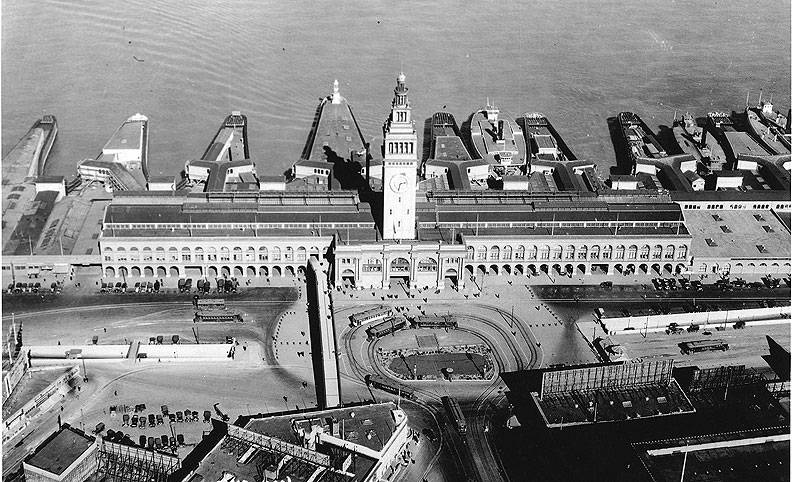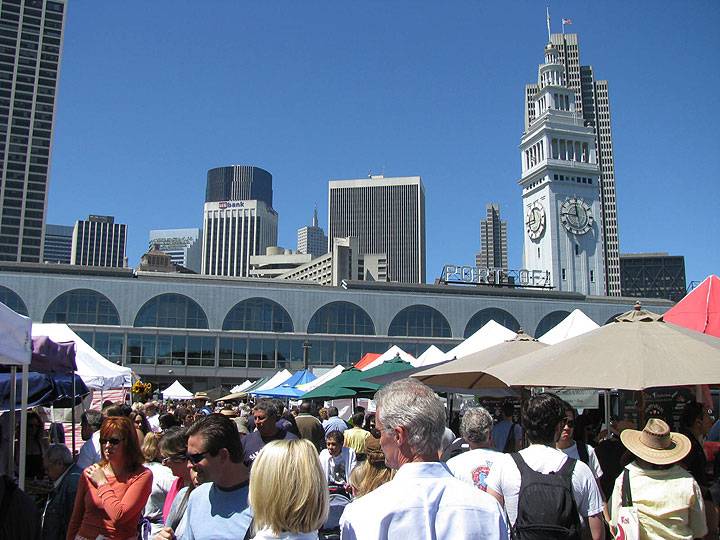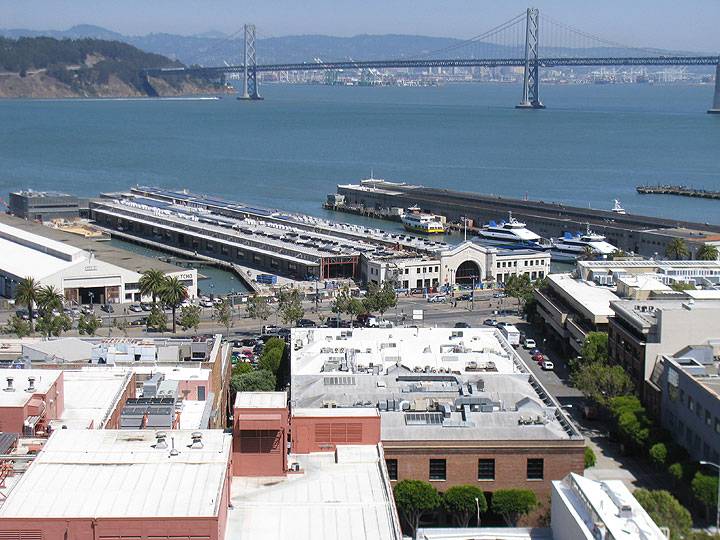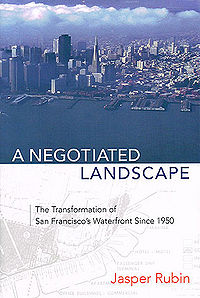A Waterfront for the People?
Historical Essay
by Jasper Rubin
Aerial of the Port of San Francisco with the Ferry Building.
Photo: Port of San Francisco
The Embarcadero Roadway and other projects catalyzed by the Loma Prieta earthquake and implemented in response to some of the goals in the Waterfront Land Use Plan have reunited city and port, and in doing so, have created a new atmosphere along much of San Francisco's urban waterfront. Indeed, it would not be an exaggeration to say that already San Francisco has reclaimed much of its waterfront. But it is still important to ask "For whom?"—a question that began our story. Vendors in the Ferry Building cater to a high-end crowd; organic beef, specialty cheeses, and artisan baked breads await deep-pocketed consumers. The Saturday farmers' market is frequented by latté-carrying hipsters, aging yuppies with children, and foodies willing to spend the money for top-notch goods. Nearby at Rincon Park, two restaurants have recently opened that are not marketed to people on a budget, or for that matter, families with children. The same can be said for the new eatery at Piers 1½-3-5. Giants games are not cheap, and neither is the beer sold inside.
Saturday Farmers' Market behind the Ferry Building, 2012.
Photo: Chris Carlsson
And by and large, the active uses along much of the waterfront north of China Basin Channel are, aside from businesses in bulkhead and pier- head buildings, oriented to diversions not particularly water-oriented in nature. Spectacle and entertainment bring cash to the port. And finally, not many blue-collar maritime jobs are left. What remains of the working waterfront, aside from the wharf, is isolated in the south, far from the heart of the city for which it was once the lifeblood. One wonders how often a longshoreman or ship welder sits down at the Ferry Building for oysters and champagne. But they may take their children for a bike ride along Herb Caen Way, stop for ice cream, and watch the sea lions bark at Pier 39.
San Francisco has avoided the affliction of a modernist project of office towers, STOL ports, and other gleaming monoliths of commerce on its waterfront. The rampant privatization and narrowing of purpose that comes with unfettered commercialization has not occurred. The city has not, in a spasm of entrepreneurialism, turned over its waterfront entirely to the spectacular, to éclat. While there is no doubt that the pursuit of leisure and distraction through consumption is part of the waterfront today, it is far from unmitigated. From the remains of a working port and its gritty docks, San Francisco has also created a place of promenades, historic stateliness, long open piers, pockets of green against the blue, access to the water, and evocative vistas. Even commercial developments include features meant to draw people to the waterfront and not prevent them from venturing to the water's edge. The homeless are not forced out of these public spaces in actions tantamount to state-sanctioned violence.(44) Skateboarders and stunt-bike riders are not chased away, nor is the area controlled or surveilled in an attempt to make the place "safe" for certain groups of people.(45) The waterfront is far and away more public and civic in purpose than what was imagined for it in the past, or that one might expect in a world-class city in contemporary capitalist society.
Pier 15 under construction, being converted into the new home of the Exploratorium, August 2012.
Photo: Chris Carlsson
Geographer and preeminent urban theorist David Harvey has averred that "contestation over the construction, meaning, and organization of public space takes effect, therefore, when it succeeds in exercising a transformative influence over private and commercial spaces."(46) The processes outlined in this book provide an example of some successes in a similar struggle, in this case to protect public land against privatization and commercialization. In fact, "transformative influences" along the waterfront have actually increased the amount of civic space in San Francisco, right at the city's front door and smack dab across from a downtown aching to expand. This was made possible by institutionalizing a consciousness of the water—that is, protecting its use value for a wider public. To make the most of the opportunities presented by San Francisco's disused waterfront land has not meant unbridled market-based development in support of positioning the city globally, but as much as possible emphasizing the public importance of the area, asserting its public value. If "going global" is indeed a desirable end, then pointing to the civic aspect of the waterfront would be a different and legitimate way to lay claim to a position at the top of the world's urban hierarchy. An optimistic reading would have the waterfront as a bulwark against the neoliberal urbanization found in other parts of San Francisco—a bulwark put in place by public involvement, a progressive, green, political culture, and relatively enlightened government agencies and staff.
The right to the city, Harvey elaborates, is "far more than the individual liberty to access urban resources: it is a right to change ourselves by changing the city. It is, moreover, a common right rather than an individual right since this transformation inevitably depends upon the exercise of a collective power to reshape the process of urbanization."(47) Society must strive for what would then be a more inclusive city even if, Harvey admits, the result is continual fractiousness. However, bringing together individuals and finding and establishing common cause among disparate groups is very difficult at a practical level. But at some point, to get things done, one must be able to make decisions and strike bargains. San Francisco's waterfront is an example of a relatively successful negotiation to create a place that reflects the interests and hopes of many diverse groups and people.
The story is not over, but there seems to be real promise that use value and a right to the waterfront, and therefore a right to at least part of the city, is being secured for the citizenry, as opposed to a waterfront made primarily into a commodity by the dominance of exchange value and a capitulation to capitalist accumulation strategies. The randomness of play and encounter, the sense of belonging, the very flow of people, tourists, locals, workers, leisure seekers, homeless, skate punks, wealthy diners, and middle-class consumers, together with the myriad activists, agencies, and businesses involved in the waterfront create an instance, even if in a small way, of what Henri Lefebvre called an oeuvre—the city as a work, an assemblage of many functions, made by its people. Whether the transformation of San Francisco's waterfront represents hope for and the possibilities of an "urban revolution," or is just an isolated pocket of minor resistance, remains to be seen.
Notes
43. Walker, “Another Round of Globalization in San Francisco."
44. Don Mitchell and Lynn A. Staehelii have described the removal of homeless in downtown San Diego as part of a "Clean and Safe" business improvement district program as replacing the traditional regulation of private property with "a privatized set of rules of exclusion, and a form of violence-perhaps potential-that while retaining state sanction, is nonetheless left in the hands of private individuals" ("Clean and Safe? Property Redevelopment, Public Space, and Homelessness in Downtown San Diego," in Low and Smith, Politics of Public Space, 165.)
45. One small exception is the sea-creature-themed anti-skate-board features placed into low walls. They are a sign of the obvious, that even use value has its contestations—in this case, the decision was to reduce maintenance costs and, in some places, ensure seating is not co-opted by one group. Then again, no skate park yet exists on the waterfront.
46. David Harvey, "The Political Economy of Public Space," in Low and Smith, Politics of Public Space.
47. Harvey, "The Right to the City." Harvey borrows from Robert Park to make this point.
Excerpted with permission from A Negotiated Landscape © 2011 Jasper Rubin and the Center for American Places at Columbia College Chicago




